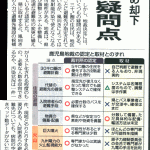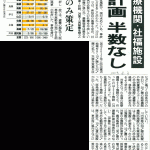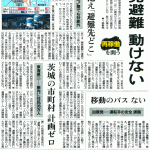Original Japanese written by staffer
The English below translated from the original Japanese by Heeday
The English translation edited by Rev. Dr. Henry French, ELCA
(Sources: articles of May 5th, 2015 edition of the Chunichi Shimbun and August 3rd, 2015 edition of the Asahi Shimbun newspapers)
▼Click each image to enlarge it and read the caption.
In Satsumasendai City, Kagoshima Prefecture, on the southern edge of the island of Kyushu, the Kyushu Electric Power Co., Inc. restarted Unit 1 of its Sendai Nuclear Power Plant, on August 11th, 2015. This is the first nuclear power plant restart approved by the Nuclear Regulation Authority, which investigates and judges the safety of Japan’s nuclear power plants.
Following the Fukushima Daiichi disaster, this Authority was made independent of any of the existing Ministries and Agencies, which are mostly promoting nuclear power.
This restart marks the end of almost two years of a “nuke-free” Japan.
Shortly after the Fukushima Daiichi meltdown began, we had one case after another of a hospitalized patient or an elderly person passing away amid the confusion that accompanied their evacuation. At Futaba Hospital and its nursing care facilities, just 4.6km (2.9 miles) away from Fukushima Daiichi, some 230 hospitalized patients and nursing care residents were left behind in the evacuation process, and 19 of them passed away in the transportation mess.
Responding to this, in 2012, the Japanese Government expanded the Priority Disaster Area from 8 to 10km (5 to 6.3 miles) of a nuclear power plant to 30km (18.8 miles). In compliance with Japan’s Disaster Countermeasure Basic Act, the Government issued a guideline targeted at municipal governments which demands each medical and welfare facility, including special elderly nursing homes, to prepare an evacuation plan which covers where to evacuate to, the evacuation routes, the means of transportation, and so on.
Of the 85 medical facilities within 30km of the Sendai Nuclear Power Plant, only two have such an evacuation plan. Of the 159 welfare facilities, only 15. Within 10km of the power plant, all the relevant facilities have such a plan in place now. In March 2015, Governor Yuichiro Ito of Kagoshima Prefecture limited, on his own decision, the area of such planning to within 10km of the plant, saying “10km is good enough. Covering up to 30km is impossible.” The Governor decided that, for those facilities located 10km or more away from the nuclear power plant, the Kagoshima Prefectural Government should coordinate where to evacuate to, depending upon wind directions and other factors. The Prefecture’s Nuclear Safety Measures Section said, “We have reached this decision with the national government’s approval.”
The Nuclear Regulation Authority, meanwhile, said it was “in no position to evaluate [evacuation plans].” (Chairperson Shun’ichi Tanaka) Thus, the Authority does not consider relevant evacuation plans as it gives the go-ahead to the restart of a nuclear power plant. Also, although the relevant law requires consent to a restart from certain municipalities, it is actually the Prefecture and the municipality hosting the nuclear plant whose consent matters. The other neighboring municipalities, while required to make evacuation plans, are legally in no position to exercise any influence over a restart decision.
In the case of the Fukushima Daiichi tragedy, the evacuation area exceeded the distance of 30km from the nuclear power plant. While much mutually contradicting information has been circulated, the fact is that numerous residents on the run were exhausted, both mentally and physically. Today, many of them are still suffering from the trauma of their agonizing experiences.
Shortly after the meltdown began, as invisible radiation spread closer to them, everyone within the vicinity of Fukushima Daiichi was simply at a loss. With the Japanese Government making only unreliable responses, every resident was overwhelmed by anxiety. Each and every one was forced to make a serious choice – to flee, or to stay. Yet the transportation system was paralyzed, with gasoline in serious shortage. There was discrimination between those who were able to escape and those who were not able to. As we witnessed with our own eyes, those in the more vulnerable positions of society, women, children, patients, etc., faced tougher hardships.
Today, some experts say that what affects health is the radiation dosage one is exposed to shortly after the meltdown began. Some in the hard-hit areas, therefore, blame themselves that they did not flee. On the other hand, some of those who made it away from such areas feel guilty that they abandoned their hometowns and villages. Everyone, in and out of the affected areas, are still living with an inner conflict, unsure as to whether they made the right decision or not.
In spite of the fact that so many evacuees have been left abandoned, the Sendai Nuclear Power Plant has been restarted. I must say that those who promoted the restart have no intention of learning from the Fukushima Daiichi tragedy. In Japan, we have a saying; “A disaster hits when we have forgotten about disasters of the past.” The Fukushima Daiichi disaster is something we have to keep in mind for ages to come.



